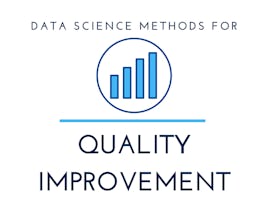COURSE 6 of 7. Fragmented healthcare has created the need for healthcare reform, changing how healthcare is delivered and managed by shifting the structure and culture of healthcare organizations across the U.S. In this course, you will explore ways that provider organizations can successfully move from volume to value through implementing Quality Improvement plans and Continuous Quality Improvement. Organizational improvement is a continuous process. To be successful means coming to grips with things you have to do, how they get done, and who needs to be involved. Paramount to the process is recognizing that every role—every team member—in the organization is important to a successful VBC strategy. You will also learn about adaptive leadership and how to advance vision and innovation through collaboration. Collaborative relationships between team members and leadership are critical to the transformation. You will explore strategies to gain buy-in, agreement, and understanding about the organization’s vision of value-based care and learn to engage team members in developing solutions to challenges. In the summative assignment, you will identify a measurable value-based care goal that would benefit from process improvement, describe how that goal will be communicated with the care team, and explain your role in leading the targeted improvements.



Value-Based Care: Quality Improvement in Organizations
This course is part of Value-Based Care Specialization


Instructors: Susie Gronseth
Sponsored by FutureX
1,978 already enrolled
(28 reviews)
Recommended experience
What you'll learn
Formulate an understanding of the relationship between using a PDSA cycle for quality improvement and the fundamental premise of value-based care.
Articulate the importance of organizational effectiveness in transitioning to and maintaining a value-based care organization.
Articulate the importance of building a high-performing care team for achieving quality improvement in healthcare.
Skills you'll gain
- Leadership Development
- Management Training And Development
- Organizational Change
- Health Care Administration
- Leadership and Management
- Strategic Leadership
- Team Management
- Talent Management
- Team Leadership
- Organizational Leadership
- Quality Improvement
- Business Transformation
- Quality Management
- Continuous Quality Improvement (CQI)
- Team Building
- Business Leadership
- Organizational Development
- People Management
- Change Management
Details to know

Add to your LinkedIn profile
2 assignments
See how employees at top companies are mastering in-demand skills

Build your subject-matter expertise
- Learn new concepts from industry experts
- Gain a foundational understanding of a subject or tool
- Develop job-relevant skills with hands-on projects
- Earn a shareable career certificate


Earn a career certificate
Add this credential to your LinkedIn profile, resume, or CV
Share it on social media and in your performance review

There are 3 modules in this course
If you participated in earlier courses, you have learned that the journey from volume to value for any provider organization is one of continuous improvement and change. Successfully moving to a value-based care agreement with a health plan takes many steps and is not completed all at once. In Course 5, new competencies, new roles and responsibilities for staff, and new financial and other measures required for a successful transition to and ongoing maintenance of a value-based care organization were examined, in addition to some of the challenges in the transition and ongoing work. Throughout, it was clearly noted that a big part of success is adopting a Quality Improvement (QI) plan. Why? What does that even mean for you and your organization? In this module, we look more closely at continuous quality improvement, or CQI. In this course, you will again hear the theme, “This is not once and done.” Organizational improvement is a continuous process. To be successful means coming to grips with things you have to do, how they get done, and who needs to be involved. This statement is not intended to overwhelm, as often a small change can make a huge difference. However, paramount to the process is recognizing that every role—every team member—in the organization is important to a successful VBC strategy. Remember, as you read or hear terms or concepts that are new to you, have your digital (Word doc) or analog (paper) notepad handy to write them down. At any time, you can use your favorite search engine to learn more. Be a self-directed learner!
What's included
9 videos1 reading1 assignment1 discussion prompt3 plugins
Fragmented healthcare has created the need for healthcare reform. This requires changing how healthcare is delivered and managed by changing the structure and culture of healthcare organizations across the U.S. However, as you explored in previous courses or may know from experience, successful transformation of the current system of fragmented, high-cost, ineffective care to one that is built on coordinated, efficient, and effective care cannot be accomplished quickly. While decisions must be made to determine strategic directions and obstacles have to be resolved, the process is a steady, thoughtful, and reflective journey. And, the key to success is an adaptive leadership able to advance vision and innovation through collaboration. Collaborative relationships between team members and leadership are critical to the transformation. This is not the time to direct teams, but instead to gain buy-in, agreement, and understanding about the organization’s strategy for and vision of value-based care. Listen, understand, and engage team members in developing solutions to challenges, workflows, etc. that directly impact them. Empowering, inspiring, respecting, and valuing team members will lead to the best decisions, care, and outcomes for patients. Believing in team member abilities leads to everyone reaping the benefits—from staff to patients, family members, other customers, and vendors. As the organization transforms, a new culture emerges with the common goal of supporting and advancing how value-based healthcare is delivered. Remember, as you read or hear terms or concepts that are new to you, have your digital (Word doc) or analog (paper) notepad handy to write them down. At any time, you can use your favorite search engine to learn more. Be a self-directed learner!
What's included
14 videos1 reading1 assignment1 discussion prompt
What's included
1 peer review1 plugin
Instructors

Offered by
Why people choose Coursera for their career




Learner reviews
28 reviews
- 5 stars
75%
- 4 stars
21.42%
- 3 stars
0%
- 2 stars
0%
- 1 star
3.57%
Showing 3 of 28
Reviewed on Sep 18, 2023
Really interesting, lively, engaging, informative.
Recommended if you're interested in Health

University of Colorado Boulder

Northeastern University

Johns Hopkins University

Imperial College London

Open new doors with Coursera Plus
Unlimited access to 10,000+ world-class courses, hands-on projects, and job-ready certificate programs - all included in your subscription
Advance your career with an online degree
Earn a degree from world-class universities - 100% online
Join over 3,400 global companies that choose Coursera for Business
Upskill your employees to excel in the digital economy


